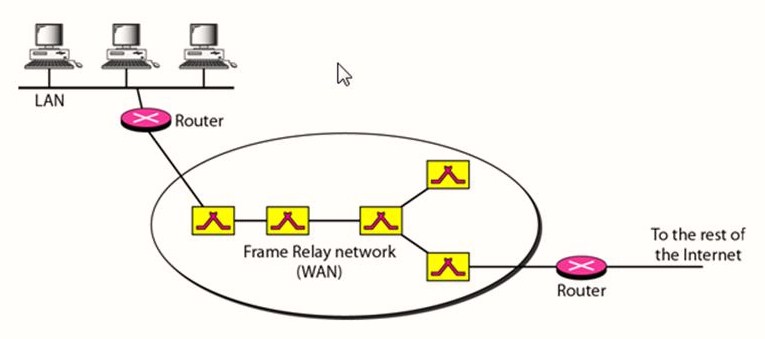

Switching Technique Large messages broken up into smaller packets Datagram Each packet sent independently of the others No call setup More reliable (can route around failed nodes or congestion) Virtual circuit Fixed route established before any packets sent No need for routing decision for each packet at each node ĭisadvantages relative to Circuit-Switching Packets incur additional delay with every node they pass through Jitter : variation in packet delay Data overhead in every packet for routing information, etc Processing overhead for every packet at every node traversed When traffic becomes heavy on a circuit-switching network, some calls are blocked.
FRAME RELAY SIMPLEDIAGRAMS PLUS
Packet-Switching Data transmitted in short blocks, or packets Packet length Each packet contains user data plus control info (routing) Store and forward Īdvantages with compared to Circuit-Switching Greater line efficiency (many packets can go over shared link) Data rate conversions Non-blocking under heavy traffic (but increased delays).
FRAME RELAY SIMPLEDIAGRAMS SERIAL
Serial Point-to-Point Connection Network connections at the CSU/DSU EIA/TIA-232 EIA/TIA-449 EIA-530 V.35 X.21 End user device Service Provider DTE DCE Router connectionsĬircuit-Switching Long-haul telecom network designed for voice Network resources dedicated to one call Shortcomings when used for data: Inefficient (high idle time) Constant data rate

One of the commonly used physical layer interface specifications is the recommended standard (RS)-232. The physical component defines the mechanical, electrical, functional, and procedural specifications for the connection between the devices. įrame Relay Devices (cont.) The connection between a DTE device and a DCE device consists of both a physical layer component (L1) and a link layer component (L2). The purpose of DCE equipments is to provide clocking and switching services in a network, which are the devices that actually transmit data through the WAN. Data circuit-terminating equipment (DCE) DCEs are carrier-owned internetworking devices. Example of DTE devices are terminals, personal computers, routers, and bridges. įrame Relay Devices Devices attached to a Frame Relay WAN fall into the following two general categories: Data terminal equipment (DTE) DTEs generally are considered to be terminating equipment for a specific network and typically are located on the premises of a customer. However, it is being replaced in some areas by faster technologies, such as ATM. Frame Relay is quite popular because it is relatively inexpensive.

(In Europe, FR’s speeds vary from 64 Kb/s to 2 Mb/s. Most telephone companies now provide FR service for customers who want connections at 56 Kb/s to T-1 speeds. In fact, you can think of Frame Relay as a way of utilizing existing T-1 and T-3 lines owned by a service provider. What is Frame Relay? “ A packet-switching protocol for connecting devices on a Wide Area Network (WAN) ” FR networks support data transfer rates at T-1 (1.544 Mb/s) T-3 (45 Mb/s) speeds. FR is an example of a packet-switched technology. Today, it is used over a variety of other network interfaces as well. FR originally was designed for use across Integrated Service Digital Network (ISDN) interfaces. Introduction Frame Relay (FR) is a high-performance WAN protocol that operates at the physical and data link layers of the OSI reference model. The end points have the responsibility for detecting and retransmitting dropped frames. When a Frame Relay network detects an error in a frame, it simply drops that frame. Unlike X.25, whose designers expected analog signals, Frame Relay offers a fast packet technology, which means that the protocol does not attempt to correct errors. NDSL, Chang Gung Universityįrame Relay has its technical base in the older X.25 packet-switching technology, designed for transmitting data on analog voice lines. For most services, the network provides a permanent virtual circuit (PVC), which means that the customer sees a continuous, dedicated connection without having to pay for a full-time leased line, while the service-provider figures out the route each frame travels to its destination and can charge based on usage. This speeds up overall data transmission. Frame Relay puts data in variable-size units called 'frames' and leaves any necessary error-correction (such as re-transmission of data) up to the end-points.

Frame Relay To provide a telecommunication service for cost-efficient data transmission for intermittent traffic between local area networks (LANs) and between end-points in a wide area network (WAN).


 0 kommentar(er)
0 kommentar(er)
